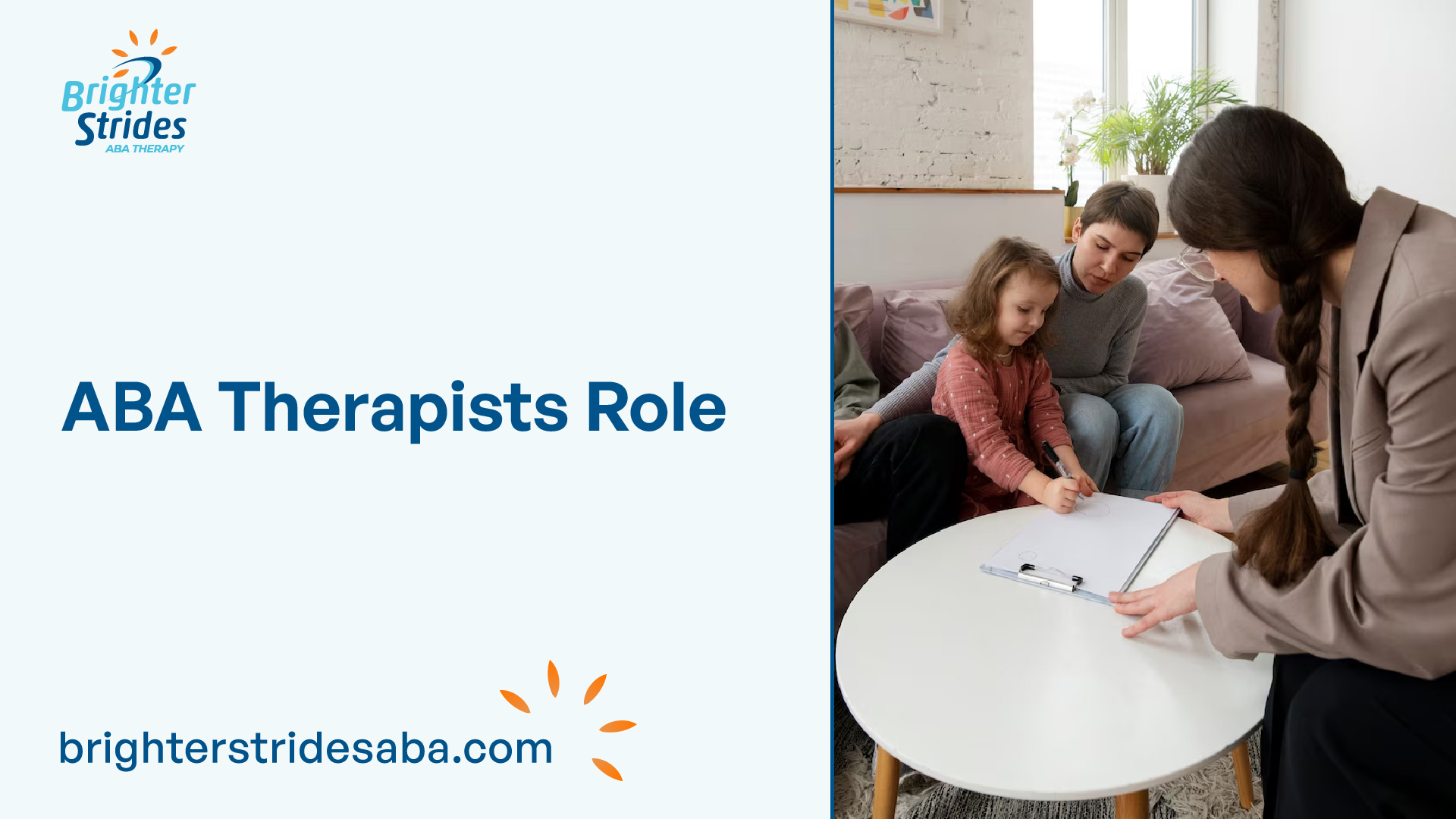
Understanding ABA Therapy
ABA Therapy, or Applied Behavior Analysis therapy, is an evidence-based approach primarily used to help individuals with developmental disabilities, such as autism spectrum disorder (ASD). Its goal is to improve socially significant behaviors by teaching new skills and reducing problematic behaviors through structured and data-driven interventions. The role of an ABA therapist is crucial in the success of individuals undergoing ABA therapy.
Role of ABA Therapists
ABA therapists, also known as behavior analysts, primarily work with children who have developmental or intellectual disabilities, such as autism. They play a critical role in helping these individuals improve social skills and address behavioral issues [1]. ABA therapists create a safe environment for individuals to participate in learning-based activities and develop communication skills that lead to a more independent future [2].
The responsibilities of an ABA therapist include:
- Conducting assessments to identify target behaviors and establish baseline data.
- Designing and implementing individualized treatment plans based on the needs of each individual.
- Collecting data on behavior and progress to monitor changes and make data-driven decisions.
- Providing direct instruction to individuals, teaching them new skills and strategies to manage behavior.
- Implementing behavior management techniques to address problematic behaviors effectively.
- Training caregivers and family members on generalizing skills outside of therapy sessions.
The role of an ABA therapist requires patience, empathy, and the ability to build a rapport with individuals and their families. By providing support, guidance, and evidence-based interventions, ABA therapists help individuals with developmental disabilities reach their full potential.
Importance of ABA Therapy
ABA therapy has a significant impact on the lives of individuals with developmental disabilities. By focusing on behavior modification and skill-building, ABA therapy helps individuals improve their communication, social interaction, and daily living skills. It equips them with the necessary tools to navigate the challenges they may face in their daily lives.
Research has shown that ABA therapy can lead to substantial improvements in individuals with autism, including increased language and communication skills, better social skills, reduced challenging behaviors, and improved overall quality of life [1]. The individualized programs and interventions provided by ABA therapists are tailored to the unique needs of each individual, allowing for targeted progress and skill development.
The impact of ABA therapy extends beyond the individuals undergoing treatment. It also provides support and guidance to caregivers, equipping them with strategies and techniques to reinforce skills and manage behaviors outside of therapy sessions. By actively involving caregivers in the process, ABA therapists promote consistency and generalization of skills, maximizing the effectiveness of the therapy.
ABA therapy continues to be recognized as an effective intervention for individuals with developmental disabilities. The growing demand for ABA therapists reflects the positive outcomes and benefits associated with this evidence-based approach. If you’re interested in pursuing a career in ABA therapy, it’s important to explore the diverse opportunities available and understand the educational and training requirements [4].
Key Players in ABA Therapy
In the field of Applied Behavior Analysis (ABA) therapy, several key players work together to provide effective and comprehensive support to individuals with behavioral and developmental challenges. These professionals include the Registered Behavior Technician® (RBT®), Board Certified Assistant Behavior Analyst® (BCaBA®), and Board Certified Behavior Analyst® (BCBA®).
Registered Behavior Technician® (RBT®)
A Registered Behavior Technician® (RBT®) plays a vital role in implementing behavior analysis programs under the close supervision of a BCBA, BCaBA, or FL-CBA [5]. RBTs are responsible for conducting direct therapy sessions and collecting data on client progress. They work closely with individuals of all ages, particularly children diagnosed with autism or other developmental disabilities [2].
RBTs receive specialized training and must pass a certification exam to demonstrate their competency in delivering ABA therapy. Their work focuses on implementing behavior intervention plans and teaching a range of skills, such as communication, independent living, and coping strategies.
Board Certified Assistant Behavior Analyst® (BCaBA®)
A Board Certified Assistant Behavior Analyst® (BCaBA®) is an undergraduate-level professional in behavior analysis who works under the supervision of a BCBA or FL-CBA [5]. BCaBAs provide direct services to clients, implement behavior intervention plans, and collect data on progress. They play a crucial role in supporting individuals with behavioral and developmental challenges.
BCaBAs have completed coursework and practical training in behavior analysis, allowing them to apply evidence-based strategies in their work. They contribute to the development and implementation of behavior intervention plans, helping individuals acquire new skills and improve their overall quality of life.
Board Certified Behavior Analyst® (BCBA®)
A Board Certified Behavior Analyst® (BCBA®) is a highly trained professional in behavior analysis who holds a graduate-level degree in the field. BCBAs can practice independently and provide supervision to BCaBAs and RBTs [5]. They play a crucial role in evaluating clients, developing individualized programs, and overseeing the work of ABA therapists to ensure clients are making progress [2].
BCBAs conduct assessments, analyze data, and design behavior intervention plans tailored to the specific needs of each client. They collaborate with other professionals, such as speech therapists, occupational therapists, and educators, to create comprehensive treatment plans. BCBAs also provide ongoing supervision and training to ensure that ABA therapy is implemented effectively and ethically.
These key players in ABA therapy work together to provide effective and evidence-based interventions to individuals with behavioral and developmental challenges. By applying behavior analysis principles and strategies, they support clients in acquiring new skills, reducing problematic behaviors, and achieving meaningful progress.

Behavior Intervention Plans in ABA
Behavior Intervention Plans (BIPs) play a crucial role in the field of Applied Behavior Analysis (ABA). These plans are designed to address challenging behaviors and promote positive change in individuals. By providing a structured framework, BIPs aim to improve the individual’s quality of life, enhance their social interactions, and increase their overall well-being [6].
Purpose of Behavior Intervention Plans
The primary purpose of a Behavior Intervention Plan is to provide a proactive and individualized approach to managing challenging behaviors. These plans are developed based on a thorough assessment of the individual’s behavior, known as a Functional Behavior Assessment (FBA). The FBA helps identify the underlying functions and triggers of the challenging behaviors, enabling the development of targeted interventions and strategies.
By implementing a Behavior Intervention Plan, the goal is to replace the challenging behavior with more appropriate and socially acceptable alternatives. The plan focuses on teaching the individual new skills, such as communication or coping strategies, to effectively address their needs.
Components of a Behavior Intervention Plan
A well-structured Behavior Intervention Plan consists of several key components that work together to address challenging behaviors and promote positive change. These components include:
- Functional Behavior Assessment (FBA): The FBA serves as the foundation of the Behavior Intervention Plan. It involves gathering information about the antecedents, behaviors, and consequences of the challenging behavior. This assessment helps identify the function and purpose that the behavior serves for the individual.
- Goals and Objectives: Clear and measurable goals and objectives are established in the Behavior Intervention Plan. These goals are individualized and tailored to the specific needs and challenges of the individual. The goals should be realistic, achievable, and aligned with the desired outcomes.
- Strategies and Interventions: Based on the findings from the FBA, specific strategies and interventions are implemented to address the challenging behaviors. These may include teaching alternative skills, modifying the environment, providing visual supports, or implementing reinforcement strategies to promote positive behavior.
- Data Collection and Progress Monitoring: Ongoing data collection is an essential part of the Behavior Intervention Plan. Data is collected to track the individual’s progress towards their goals and objectives. Regular analysis of the collected data allows for evaluation of the effectiveness of the strategies and interventions, making adjustments as needed.
- Collaboration and Support: Developing and implementing a Behavior Intervention Plan requires collaboration among professionals from various disciplines. It is important to involve the individual and their support system, such as family members or caregivers, in the plan. Collaboration ensures consistency in approach and promotes generalization of skills across different settings.
By incorporating these components into a Behavior Intervention Plan, ABA therapists can effectively address challenging behaviors and support individuals in reaching their full potential. The individualized nature of these plans allows for tailored strategies and interventions that address the unique needs of each individual.
In the next section, we will explore effective implementation strategies for Behavior Intervention Plans and the importance of consistent monitoring and adjustments to ensure their effectiveness.
Implementing Behavior Intervention Plans
Once a Behavior Intervention Plan (BIP) has been developed, it is crucial to ensure effective implementation to promote positive behavior change. Implementing a BIP involves consistent follow-through, monitoring, and adjustments to maximize its effectiveness. Here, we will explore the strategies for effective implementation and the importance of monitoring and adjusting plans.
Effective Implementation Strategies
Implementing a Behavior Intervention Plan requires collaboration among professionals from various disciplines, including behavior analysts, therapists, educators, and caregivers. It is essential to ensure that everyone involved understands the plan and their role in its implementation. Consistency is key, as individuals with challenging behaviors thrive on predictability and routines.
To effectively implement a BIP, consider the following strategies:
- Collaboration and Communication: Foster open communication and collaboration among the entire team. Regular meetings and updates help ensure that everyone is on the same page and can address any concerns or modifications needed.
- Training and Professional Development: Provide ongoing training and professional development opportunities for the individuals involved in implementing the BIP. This ensures that they have the necessary skills and knowledge to execute the plan effectively.
- Clear and Concise Instructions: Clearly outline the strategies and techniques to be used in the BIP. Provide step-by-step instructions and examples to ensure consistency in implementation.
- Reinforcement and Rewards: Implement a system of positive reinforcement for individuals involved in carrying out the BIP. Recognize and reward their efforts to maintain motivation and consistency.
- Data Collection: Regularly collect data to monitor progress and evaluate the effectiveness of the BIP. This data provides valuable insights into how the individual is responding to the interventions and allows for adjustments if needed.
Monitoring and Adjusting Plans
Monitoring and adjusting a Behavior Intervention Plan is a critical aspect of ensuring its effectiveness. A well-written BIP is not static but rather a living document that requires ongoing evaluation and modifications. By closely monitoring the individual’s progress and assessing the impact of the interventions, adjustments can be made to optimize outcomes.
Key considerations for monitoring and adjusting behavior intervention plans include:
- Data Analysis: Analyze the data collected during the implementation of the BIP. Look for patterns and trends in behavior, noting any changes or improvements.
- Functional Behavior Assessment (FBA): Conduct a functional behavior assessment to gain a deeper understanding of the maintaining variables of the behavior. This assessment helps in developing a hypothesis for the behavior and tailoring interventions accordingly.
- Collaborative Review: Regularly schedule collaborative reviews of the BIP with the entire team. Evaluate the effectiveness of the interventions and discuss any necessary modifications or additions based on the data and observations.
- Individualized Approach: Recognize that each individual’s response to interventions may differ. Adjustments should be individualized and tailored to the specific needs and progress of the individual.
By consistently monitoring and adjusting the BIP, professionals can ensure that the interventions remain effective and aligned with the individual’s goals. This iterative process allows for ongoing progress and improvement.
Implementing behavior intervention plans requires dedication, consistency, and a commitment to ongoing evaluation and adjustment. By following effective implementation strategies and monitoring progress, professionals can help individuals achieve positive behavior change and improve their overall quality of life.
ABA Therapy Techniques
ABA therapy employs various techniques rooted in behavior analysis principles to bring about positive behavioral changes. Two key techniques utilized by ABA therapists are behavior analysis principles and positive reinforcement strategies.
Behavior Analysis Principles
Behavior analysis principles form the foundation of ABA therapy. ABA therapists use these principles to understand and modify behavior. Some key behavior analysis principles include:
- Reinforcement: Reinforcement involves providing consequences that increase the likelihood of a specific behavior occurring again in the future. ABA therapists identify and utilize reinforcers that are meaningful to the individual receiving therapy. This could include praise, tokens, or access to preferred activities or items.
- Prompting: Prompting involves providing cues or assistance to help an individual initiate or complete a desired behavior. Prompting can be verbal, visual, physical, or gestural, depending on the needs and abilities of the individual.
- Shaping: Shaping involves breaking down a desired behavior into smaller, manageable steps and reinforcing each successive approximation of the behavior. ABA therapists gradually shape the behavior until the individual achieves the target behavior.
- Generalization: Generalization refers to the individual’s ability to demonstrate the acquired skills in different environments, with different people, and in various situations. ABA therapists work on promoting generalization to ensure that the skills learned during therapy are applied in real-life settings.
Positive Reinforcement Strategies
Positive reinforcement is a powerful tool used in ABA therapy to motivate and reinforce desired behaviors. ABA therapists identify and implement positive reinforcement strategies tailored to each individual. These strategies involve providing rewards or preferred stimuli immediately following the performance of a target behavior.
By using positive reinforcement, ABA therapists aim to increase the occurrence of desired behaviors and promote skill acquisition. The specific reinforcement strategies used may vary depending on the individual’s preferences and needs. Some common positive reinforcement strategies include:
- Verbal praise: A simple and effective method of providing positive reinforcement is through verbal praise. ABA therapists use specific and genuine praise to acknowledge and reinforce the individual’s efforts and achievements.
- Token systems: Token systems involve the use of tokens or points that can be exchanged for preferred items, activities, or privileges. This allows individuals to earn tokens for displaying desired behaviors and provides them with a visual representation of their progress.
- Social rewards: Social rewards can include activities such as playing with peers, receiving attention, or engaging in preferred social interactions. ABA therapists use social rewards to reinforce appropriate social skills and encourage positive interactions.
- Tangible rewards: Tangible rewards involve providing individuals with preferred items, such as stickers, small toys, or treats, as a form of positive reinforcement. These rewards are tailored to the individual’s preferences and can be used to motivate and reinforce desired behaviors.
By utilizing behavior analysis principles and positive reinforcement strategies, ABA therapists help individuals develop new skills, reduce challenging behaviors, and enhance their overall quality of life. These techniques are applied in conjunction with other components of ABA therapy to create individualized programs that address specific needs and goals.

Career Paths in ABA Therapy
For individuals interested in pursuing a career in ABA therapy, there are diverse opportunities available that allow professionals to make a meaningful impact on the lives of individuals with developmental disabilities. ABA therapists can work in various settings, collaborate with multidisciplinary teams, and provide targeted interventions to promote positive outcomes.
Diverse Opportunities
ABA therapists have the flexibility to choose from a range of career paths within the field. They can work in clinical settings, schools, residential care facilities, hospitals, or even start their own private practice. Each of these paths offers unique opportunities to work with different populations and contribute to the development and implementation of individualized programs [7]. ABA therapists may also pursue roles such as ABA training coordinator, clinical supervisor, university professor, or clinical director, allowing for career growth and specialization [8].
Working in various settings provides ABA therapists with the chance to collaborate with professionals from different disciplines. Depending on the setting, ABA therapists may work alongside medical doctors, psychiatrists, psychologists, teachers, and administrators [9]. This multidisciplinary collaboration enhances the effectiveness of interventions and promotes holistic care for individuals receiving ABA therapy.
Educational and Training Requirements
To embark on a career as an ABA therapist, individuals typically need to earn at least a master’s degree in a field such as applied behavior analysis. However, some entry-level positions may only require a bachelor’s degree in psychology or education. Obtaining licensure and certification is an essential step for ABA therapists to practice in the field. Certification is particularly important for those aspiring to open their own private practice or advance to higher-level positions in the field. It demonstrates expertise and adherence to professional standards.
While specific requirements may vary by state or employer, obtaining certification as a Board Certified Behavior Analyst® (BCBA®) is a widely recognized achievement within the field of ABA therapy. This certification demonstrates proficiency in the principles and practices of behavior analysis and is typically required for more advanced positions. Additionally, continuing education and participation in workshops and conferences help ABA therapists stay up-to-date with the latest research, techniques, and ABA clinical guidelines [10].
When considering a career in ABA therapy, it’s also important to note the potential salary range. According to the U.S. Bureau of Labor Statistics (BLS), as of May 2020, individuals working as substance abuse, behavioral disorder, or mental health counselors, which includes ABA therapists, earned a median annual salary of $47,660. Salaries can vary based on factors such as experience, location, and work setting [8].
By pursuing a career in ABA therapy, individuals can find fulfillment in supporting individuals with developmental disabilities, making positive changes in their lives, and contributing to their overall well-being. The diverse opportunities and educational requirements within the field allow ABA therapists to continuously grow and expand their knowledge, ultimately enhancing their ability to provide effective interventions and improve outcomes for those they serve.

 We've just released an article!
Check out our blog!
We've just released an article!
Check out our blog!



